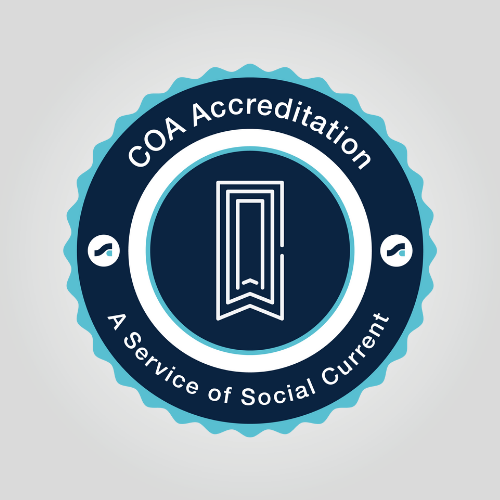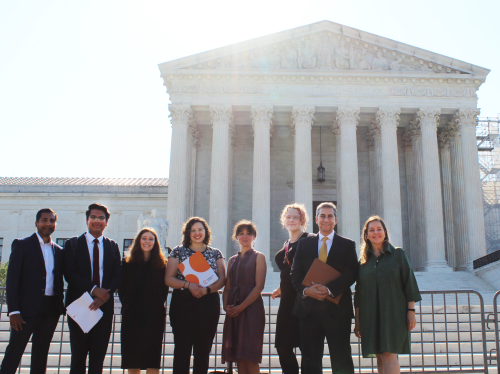March 22, 2022 @ 3:00 pm – 3:30 pm EDT
This free 30-minute webinar provides an introduction to Social Current and COA Accreditation. It is perfect for anyone seeking accreditation for the first time, interested in what is required to become accredited, or mandated to become accredited by state or federal legislation.
Participants will gain an understanding of the key concepts that define COA Accreditation, the steps toward becoming accredited, and the benefits of accreditation. There will also be a Q&A portion for us to answer any questions you might have.
Presenter

Joe Perrow
Network Growth Manager
Social Current
Related Events
March 10, 2022 @ 3:00 pm – 3:30 pm EST
This free 30-minute webinar provides an introduction to Social Current and COA Accreditation. It is perfect for anyone seeking accreditation for the first time, interested in what is required to become accredited, or mandated to become accredited by state or federal legislation.
Participants will gain an understanding of the key concepts that define COA Accreditation, the steps toward becoming accredited, and the benefits of accreditation. There will also be a Q&A portion for us to answer any questions you might have.
Presenter

Joe Perrow
Network Growth Manager
Social Current
Related Events
December 12, 2022 @ 1:30 pm – 4:30 pm EST
The Intensive Accreditation Training (IAT) is designed to prepare organizations to get the most out of their COA Accreditation experience. Topics discussed in this training include:
- An in-depth overview of the COA Accreditation process, including key milestones
- An overview of accreditation standards and the relationship between standards, evidence, and the rating indicators
- How ratings are assigned by the volunteer review team and insight on the accreditation decision-making process
- Tips on how to get organized and manage the work
- How to prepare for the site visit
COA Accreditation is offered as a service of Social Current. Learn more about COA Accreditation and how to get started online.
2022 Intensive Accreditation Trainings
This training will be offered five times in 2022. Register now for any session:
Who Should Participate
- Organization primary contacts
- Senior leaders at organizations seeking COA Accreditation
- Other staff involved in an organization’s accreditation process
Related Events
June 27, 2022 @ 1:30 pm – 4:30 pm EDT
The Intensive Accreditation Training (IAT) is designed to prepare organizations to get the most out of their COA Accreditation experience. Topics discussed in this training include:
- An in-depth overview of the COA Accreditation process, including key milestones
- An overview of accreditation standards and the relationship between standards, evidence, and the rating indicators
- How ratings are assigned by the volunteer review team and insight on the accreditation decision-making process
- Tips on how to get organized and manage the work
- How to prepare for the site visit
COA Accreditation is offered as a service of Social Current. Learn more about COA Accreditation and how to get started online.
2022 Intensive Accreditation Trainings
This training will be offered six times in 2022. Register now for any session:
Who Should Participate
- Organization primary contacts
- Senior leaders at organizations seeking COA Accreditation
- Other staff involved in an organization’s accreditation process
Related Events
April 25, 2022 @ 1:30 pm – 4:30 pm EDT
The Intensive Accreditation Training (IAT) is designed to prepare organizations to get the most out of their COA Accreditation experience. Topics discussed in this training include:
- An in-depth overview of the COA Accreditation process, including key milestones
- An overview of accreditation standards and the relationship between standards, evidence, and the rating indicators
- How ratings are assigned by the volunteer review team and insight on the accreditation decision-making process
- Tips on how to get organized and manage the work
- How to prepare for the site visit
COA Accreditation is offered as a service of Social Current. Learn more about COA Accreditation and how to get started online.
2022 Intensive Accreditation Trainings
This training will be offered six times in 2022. Register now for any session:
Who Should Participate
- Organization primary contacts
- Senior leaders at organizations seeking COA Accreditation
- Other staff involved in an organization’s accreditation process
Related Events
February 16, 2022 @ 3:00 pm – 3:30 pm EST
This free 30-minute webinar provides an introduction to Social Current and COA Accreditation. It is perfect for anyone seeking accreditation for the first time, interested in what is required to become accredited, or mandated to become accredited by state or federal legislation.
Participants will gain an understanding of the key concepts that define COA Accreditation, the steps toward becoming accredited, and the benefits of accreditation. There will also be a Q&A portion for us to answer any questions you might have.
Presenter

Joe Perrow
Network Growth Manager
Social Current
Related Events
February 1, 2022 @ 3:00 pm – 3:30 pm EST
This free 30-minute webinar provides an introduction to Social Current and COA Accreditation. It is perfect for anyone seeking accreditation for the first time, interested in what is required to become accredited, or mandated to become accredited by state or federal legislation.
Participants will gain an understanding of the key concepts that define COA Accreditation, the steps toward becoming accredited, and the benefits of accreditation. There will also be a Q&A portion for us to answer any questions you might have.
Presenter

Joe Perrow
Network Growth Manager
Social Current
Related Events
February 28, 2022 @ 1:30 pm – 4:30 pm EST
The Intensive Accreditation Training (IAT) is designed to prepare organizations to get the most out of their COA Accreditation experience. Topics discussed in this training include:
- An in-depth overview of the COA Accreditation process, including key milestones
- An overview of accreditation standards and the relationship between standards, evidence, and the rating indicators
- How ratings are assigned by the volunteer review team and insight on the accreditation decision-making process
- Tips on how to get organized and manage the work
- How to prepare for the site visit
COA Accreditation is offered as a service of Social Current. Learn more about COA Accreditation and how to get started online.
2022 Intensive Accreditation Trainings
This training will be offered six times in 2022. Register now for any session:
Who Should Participate
- Organization primary contacts
- Senior leaders at organizations seeking COA Accreditation
- Other staff involved in an organization’s accreditation process
Related Events
Note: This post was originally published in 2017. Now that it’s 2020, we decided to give it an update. The core information remains the same.
Social service agencies across the world have voluntarily risen to the challenge of achieving accreditation. Whether their original goal was to focus on administrative functions or service delivery quality, the accreditation process (particularly with a whole-organization accreditation approach) provides these agencies with a blueprint to refine practices simultaneously across every area of the organization. The performance of these agencies has caught the eye of oversight entities and consumers alike, prompting accreditation to be used has a regulatory tool through mandates.
The word ‘mandate’, particularly in a government context, is notorious for creating concern across service providing agencies, often because of the cost associated with those requirements. COA believes all mandates function best when paired with the funding required to meet those mandates. We encourage all regulatory entities to consider the financial impact of any imposed mandate, as it can make or break the success of these initiatives.
Though the financial concerns of these agencies are absolutely valid, we can’t ignore the positives that can come with an accreditation requirement. Through accreditation, agencies are given a path to meet a base-level of quality across administrative and service delivery functions. Accreditation sets clear service expectations for service recipients and the taxpayers that fund these programs alike. It also fosters a culture of continuous improvement that can ensure the sustainability of an agency’s services. We cannot ignore the importance of these tenets in growing and maintaining a strong social service system that meets the needs of our communities.
To hopefully make this all a little easier on your organization, we’ve creating this guide to support your agency in navigating a mandate. Our goal is to help you gather important details, understand what is required, determine milestones, and know how to compare and contrast accreditors.
Note: Our best advice is don’t delay! Expect that it will take up to six months to determine an accreditor and then 12-18 months to pursue and achieve accreditation.
Questions for the entity that mandated your accreditation
What accrediting bodies are accepted?
Usually a mandate will include a list of accepted accreditors. If this isn’t included, reach out to the payer to find out what accreditors are accepted. If your preferred accrediting body isn’t recognized, we encourage you to reach out to that accrediting body and let them know. We can only speak for COA, but we are always willing to work with you and regulating entities to have COA accreditation be accepted under a mandate.
What service(s) is/are mandated?
Does the mandate apply to one service? Many services? The entire organization? Is there a document that crosswalks which services are mandated and what standards need to be applied by the accreditors? COA Accreditation Coordinators often know which service standard assignments are required for a mandate, but we always think it’s best for you yourself reach out to your regulatory entity to determine what is exactly required for your agency and the services you are providing.
What is due and when?
Mandates often come with specific timelines and may even have multiple milestone requirements. In these instances, regulating entities will designate a deadline for achievement of accreditation. To ensure organizations are on track to meet a deadline, regulating entities will designate milestone deadlines on the way to an accreditation award – a date by which organizations must engage with an accreditor, a date by which organizations must have their Site Visit, and then a date by which an award must be received.
What type of accreditation award is needed?
It’s important to clarify what type of accreditation award is due and when. Some accreditors offer provisional or temporary accreditation. Accreditors and regulatory entities will work with your organization to determine the type of accreditation award that is required under your mandate.
Evaluating accreditors — features to consider
Once you know which of your programs needs to be accredited, by when, and by whom, reach out to all the approved accreditors and get an understanding the features of each. Regulatory entities and some membership groups will often facilitate panels with all recognized accreditors to help providers select the accreditor that is best for their agency. Here are some questions you’ll want to ask:
How much does your accreditation process cost?
Ask about application fees, accreditation fees, Site Visit fees (scheduled and unscheduled), and maintenance fees. Is there a fee to purchase the standards? If so, how many copies will you need and how often will updates be published in the future? Make sure to ask about required fees and optional fees. For example, trainings might be required and have associated fees.
What is awarded and how long is it valid?
Each accrediting body will have a different length of accreditation award. This is referred to as an ‘accreditation cycle’, which will let you know how long your award is valid and how often you can expect to go through the accreditation process. Some mandates require a specific award length, in these cases the approved accreditors have worked with your oversight entity to meet this regulatory requirement. It’s important to keep all of this in mind when evaluating cost – how many accreditation cycles will your organization undergo over time (including provisional cycles)?
What is included in the accreditation review?
Will the accreditor require all programs to pursue accreditation, or can you isolate individual programs? Will the administration and management areas of the organization be reviewed? Will every site be visited in the review (important to keep in mind when considering cost!)? Does the approach of the accreditor fit your organizational culture? Does the accreditation cover all of the desired service areas (current and future growth plans)?
We encourage all agencies to look toward future mandates as well. We have often seen additional services mandated, and agencies that utilized an accreditor with a whole-organization approach are most prepared for any mandate that comes their way.
How long does it take?
Most accreditation processes take 12-18 months from deciding to pursue to decision. However, the right time to sign up might vary with each accreditor. For example, some accreditors want to hear from you when you’re ready for your Site Visit within 4-6 months. Other accreditors want you to apply before your self-assessment period so that they can work alongside your organization in preparation for the Site Visit.
How is my organization supported throughout the process?
Are you assigned a point person to work with from the accrediting body? Does the accreditor offer trainings? How and when can you ask questions? Does the accreditor provide templates and other tools to support you? Is there an online management system to assist with managing the process? Though every accreditor provides different tools to support agencies in meeting their mandate, it’s important to assess how much guidance and assistance will help your agency thrive in this process.
What is required to maintain our accreditation status?
Once accredited, what is your responsibility for self-reporting changes at your organization? What is the process when your organization adds a new program or a new site? Are there annual reporting requirements and fees? What is your responsibility when it comes to implementation when standards change?
Seek recommendations
Ask peer organizations
Contact a few peer agencies that are already accredited. Think about the characteristics you should consider when identifying a peer – is it population they serve? Their size? Location? Mission? Ask your peers about their satisfaction with the accreditation process, how they managed the work, and when appropriate, if they’d be willing to be a resource while you pursue accreditation.
Ask internally – staff, board members, and volunteers
Start a discussion about their accreditation experiences and what they liked or disliked about the process. This is also an opportunity to gauge interest to see who would be willing to be part of the accreditation team or even lead the accreditation effort within your organization.
Ask your membership associations
If you belong to an association, ask if they support accreditation. Some associations have relationships with accreditors which might make your organization eligible for a discount when pursuing the process. Some offer technical assistance, and many are willing to facilitate dialogue around accreditation.
Hopefully, this information will assist your organization with mapping out your journey towards seeking accreditation.
Here are some related resources we have available.
- Tips for Creating Effective Workgroups
- What’s the difference between accreditation, licensing and certification?
- Accreditor Comparison
Please feel free to share other resources you’ve found helpful while navigating this topic in the comments below!
The Council on Accreditation (COA) realizes that the current COVID-19 environment has presented organizations with a myriad of operational challenges as they continue to operate and provide services in this new environment. This is even more pronounced for those organizations seeking accreditation to meet the Family First Prevention Services Act (FFPSA) mandate deadlines.
To help alleviate some of the burden that organizations are currently facing, COA is providing a new Phased Accreditation option for new organizations seeking accreditation under the FFPSA mandate. This new option will allow organizations to first achieve QRTP accreditation in advance of achieving full-organizational accreditation.
What is Phased Accreditation?
COA’s Phased Accreditation provides an organization the opportunity to accredit the mandated QRTP service area first, based on a mutually agreed upon timetable and focused standards. The organization will then immediately proceed to its pursuit of full-organizational accreditation, in keeping with COA’s philosophy on accreditation.
Who is eligible?
New Private organizations seeking accreditation under the FFPSA mandate.
How do organizations benefit?
The Phased Accreditation option allows organizations to expedite the timeline to accredit the mandated service area while allowing the organization additional time to complete full-organizational accreditation. This approach allows organizations to achieve QRTP Accreditation in approximately 6-8 months.
Upon successful completion of the QRTP accreditation, the organization’s program will be accredited for four years. If the organization’s remaining services are accredited within a year of the QRTP accreditation, the organization will be accredited for four years from the decision date of the organization-wide accreditation (up to 5 years).
What are the Accreditation and Site Visit fees?
Our standard Private Accreditation and Site Visit fees apply. Members of our Sponsoring Organizations still receive the 25% discount on their Accreditation fee. There will be an additional Site Visit and fee of $2,200 per reviewer for the QRTP portion of the Phased Accreditation. The initial Phased Accreditation Site Visit will most likely be comprised of a single Peer Reviewer.
To learn more about our Phased Accreditation approach, please reach out to Joe Perrow.




